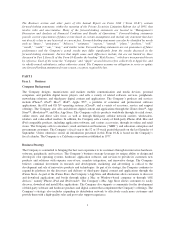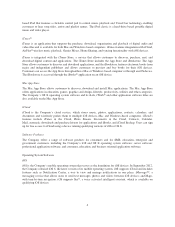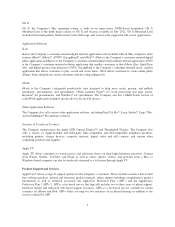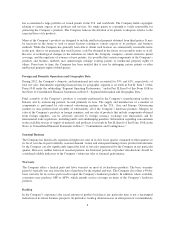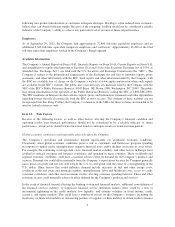Apple 2012 Annual Report Download - page 12
Download and view the complete annual report
Please find page 12 of the 2012 Apple annual report below. You can navigate through the pages in the report by either clicking on the pages listed below, or by using the keyword search tool below to find specific information within the annual report.been particularly intense as competitors selling Windows-based personal computers have aggressively cut prices
and lowered product margins. An increasing number of Internet-enabled devices that include software
applications and are smaller and simpler than traditional personal computers compete for market share with the
Company’s existing products. The Company’s financial condition and operating results depend substantially on
its ability to continually improve the Mac platform to maintain its functional and design advantages.
There can be no assurance the Company will be able to continue to provide products and services that compete
effectively.
To remain competitive and stimulate customer demand, the Company must successfully manage frequent product
introductions and transitions.
Due to the highly volatile and competitive nature of the industries in which the Company competes, the
Company must continually introduce new products, services and technologies, enhance existing products and
services, and effectively stimulate customer demand for new and upgraded products. The success of new product
introductions depends on a number of factors including, but not limited to, timely and successful product
development, market acceptance, the Company’s ability to manage the risks associated with new product
production ramp-up issues, the availability of application software for new products, the effective management of
purchase commitments and inventory levels in line with anticipated product demand, the availability of products
in appropriate quantities and costs to meet anticipated demand, and the risk that new products may have quality
or other defects in the early stages of introduction. Accordingly, the Company cannot determine in advance the
ultimate effect of new product introductions and transitions.
The Company faces substantial inventory and other asset risk in addition to purchase commitment cancellation
risk.
The Company records a write-down for product and component inventories that have become obsolete or exceed
anticipated demand or net realizable value and accrues necessary cancellation fee reserves for orders of excess
products and components. The Company also reviews its long-lived assets, including capital assets held at its
suppliers’ facilities, for impairment whenever events or circumstances indicate the carrying amount of an asset
may not be recoverable. If the Company determines that impairment has occurred, it records a write-down equal
to the amount by which the carrying value of the assets exceeds its fair market value. Although the Company
believes its provisions related to inventory, capital assets, other assets and purchase commitments are currently
adequate, no assurance can be given that the Company will not incur additional related charges given the rapid
and unpredictable pace of product obsolescence in the industries in which the Company competes.
The Company must order components for its products and build inventory in advance of product announcements
and shipments. Consistent with industry practice, components are normally acquired through a combination of
purchase orders, supplier contracts, open orders and, where appropriate, inventory component prepayments, in
each case based on projected demand. Such purchase commitments typically cover forecasted component and
manufacturing requirements for periods up to 150 days. Because the Company’s markets are volatile,
competitive and subject to rapid technology and price changes, there is a risk the Company will forecast
incorrectly and order or produce excess or insufficient amounts of components or products, or not fully utilize
firm purchase commitments.
Future operating results depend upon the Company’s ability to obtain components in sufficient quantities.
Because the Company currently obtains components from single or limited sources, the Company is subject to
significant supply and pricing risks. Many components, including those that are available from multiple sources,
are at times subject to industry-wide shortages and significant commodity pricing fluctuations. While the
Company has entered into various agreements for the supply of components, there can be no assurance that the
Company will be able to extend or renew these agreements on similar terms, or at all. The follow-on effects from
11


